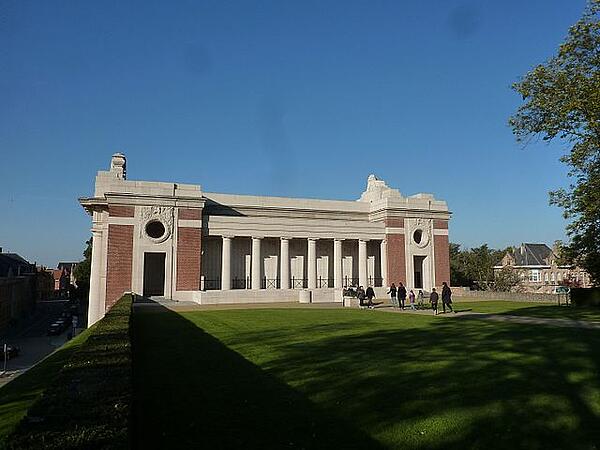The Menin Gate
The Menin Gate in Ypres is one of the most visited war memorials in Western Europe. Although there was no gate like the current one during the war, the memorial honours the men who marched to the front line to fight in the Battles of Ypres, passing through a gap in the town’s old ramparts and crossing a small stretch of water to do so.
Ironically, the route was considered very vulnerable to shelling, so there were actually far more men leaving for the front line via other routes around the town than there were leaving via this route. However, those who did leave via this route would now have their paths flanked by the statues of two lions.
Many thousands of men passed over this route - many marching to their deaths - so it was deemed appropriate that a monument should be built to commemorate those who had died during the war but had no final resting place. The Menin Gate was designed by Sir Reginald Blomfield on behalf of the Imperial War Graves Commission to fulfil this criteria, and was completed in July 1927.

There are many cemeteries around Ypres but these are mostly home to the graves of men who were identified and then buried with a headstone. However, they also have head stones marked “Known unto God” or “A Soldier of the Great War” for soldiers whose bodies were found and could be buried but whose names could not be found. There are around 40,000 of these unnamed headstones around the Ypres Salient.
The Menin Gate, on the other hand, was built specifically for those whose bodies were never found. Lieutenant Alex Helmer is one of the names on the Menin Gate. He was originally buried in a rudimentary grave art Essex Farm but the fighting that took place around the area after his death meant that his grave was destroyed so he now has no known resulting place. It was Helmer’s death in particular that inspired Lieutenant-Colonel John McCrae to write “In Flanders Field”, although he is just one of 54,896 men who died between the start and the end of the war but have no known grave.
The design from Blomfield was created specifically so that the statues of lions would have been seen by the soldiers as they moved to the front line. The carved lion on the eastern side of the memorial faces out to the front line with the inscription: “Not fierce or truculent, but patient and enduring, looking outward”. The western end of the gate looks back towards Ypres and is inscribed with: “To the armies of the British Empire who stood here from 1914 to 1918 and to those of their dead who have no known grave”.
At the inauguration ceremony for the Menin Gate on 24th July 1927, the buglers of the Somerset Light Infantry sounded the ‘Last Post’. Since then, the ‘Last Post’ has been played every night at 20:00 in a simple ceremony conduced by the buglers from the Ypres Fire Brigade. The only time this was not done was during the German occupation of Belgium in World War Two, but it was restarted every night when the Germans left.
Upon unveiling the Menin Gate, Field Marshal Plumber said the following:
“One of the most tragic features of the Great War was the number of casualties reported as “missing, believed killed. When peace came, and the last ray of hope had been extinguished, the void seemed deeper and the outlook more forlorn for those who had no grave to visit, no place where they could lay tokens of loving remembrance. And it was resolved that here at Ypres, where so many of the missing are known to have fallen, there should be erected a memorial worthy of them which should give expression to the nation’s gratitude for their sacrifice and their sympathy with those who mourned them. A memorial has been erected which, in its simple grandeur, fulfils this object, and now it can be said of each one in whose honour we are assembled here today: ‘He is not missing; he is here’.”
MLA Citation/Reference
"The Menin Gate". HistoryLearning.com. 2025. Web.
